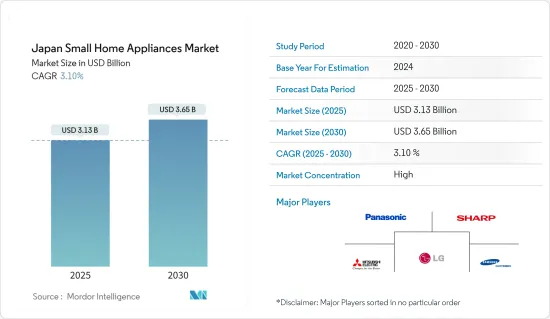
|
市場調査レポート
商品コード
1690065
日本の小型家電:市場シェア分析、産業動向・統計、成長予測(2025~2030年)Japan Small Home Appliances - Market Share Analysis, Industry Trends & Statistics, Growth Forecasts (2025 - 2030) |
||||||
カスタマイズ可能
適宜更新あり
|
|||||||
| 日本の小型家電:市場シェア分析、産業動向・統計、成長予測(2025~2030年) |
|
出版日: 2025年03月18日
発行: Mordor Intelligence
ページ情報: 英文 120 Pages
納期: 2~3営業日
|
全表示
- 概要
- 目次
日本の小型家電市場規模は2025年に31億3,000万米ドルと推定され、予測期間(2025~2030年)のCAGRは3.1%で、2030年には36億5,000万米ドルに達すると予測されます。

COVID-19のパンデミックは世界のあらゆる地域に影響を及ぼしています。コロナウイルスは何人もの命を奪っただけでなく、世界の経済構造にも影響を及ぼしています。このウイルスは市場環境を一変させ、日本の小型家電市場の成長を妨げています。日本では強制的な封鎖は行われなかったもの、企業や住民はコロナウイルス(COVID-19)の流行に備えて多くの予防措置を講じた。疾病予防を目的とした在宅勤務スタイルが会社員の間で普及していることが、消費者のさまざまな調理活動への関心を高めています。パン焼き器や電気グリルなど、時間を節約できる小型調理器具は、消費者が外食体験を制限するにつれて増加傾向にあります。
小型家電はセミポータブルまたはポータブルの機械で、一般にカウンタートップやテーブルトップなどの台で使用されます。小型家電には、空気清浄機、加湿器・除湿機、ミキサー、衣類スチーマー・アイロン、電気ケトル・コーヒーメーカーなどがあります。
技術進歩の増加、急速な都市化、住宅部門の成長、一人当たり所得の増加、生活水準の向上、家事における快適さへのニーズの急増、消費者のライフスタイルの変化、小規模世帯の増加などが日本の小型家電市場の成長を促す主要因です。
日本全国で実施されているエネルギー効率の高い家電製品に対する政府の取り組みなどの要因は、近年、エネルギー効率の高い家電製品の採用を促進すると予想されます。家電製品は時間の節約、作業の簡素化、快適性の向上に役立つため、家電製品に対する全体的な需要は都市部の家庭で増加しています。したがって、生活水準の向上と可処分所得の増加が家電製品の普及を後押しし、日本の家電製品市場の成長を牽引すると予測されます。
日本の小型家電市場動向
スマート家電ユーザーの増加が家電市場を牽引
スマート家電は幅広い家庭用機器に搭載されており、デジタル技術を駆使して機能を素早く完了させ、はるかに少ないエネルギーではるかに安いコストを実現するように設計されています。これらの機器は通常、モバイル機器やリモコンなどの便利な中央操作システムから操作できます。全体として、どんな家にも利便性と追加制御を記載しています。消費者は近代化された機器を利用し、家庭を改善する技術を採用し始めています。日本の家電市場は、ユーザーの増加と小型家電の消費の増加により、収益性の高い成長を遂げています。
オンライン販売の拡大が市場を牽引
予測期間中、オンラインセグメントが最も速い成長を見せると予想されます。オンライン流通チャネルは、eコマースプラットフォームを通じた販売を含みます。日本の消費者の間ではeコマースの人気が高まっており、小型家電市場にとって大きな機会となっています。さらに、消費者がオンライン決済バンキングソリューションに簡単にアクセスできるようになったことで、同セグメントの需要がさらに高まると予想されます。COVID-19の大流行中、日本の消費者は支出のかなりの部分をオフラインからオンライン購入に移しています。日本も例外ではないです。
日本の小型家電産業概要
本レポートでは、日本の小型家電市場で事業を展開する主要な国際企業を取り上げています。市場シェアでは、現在いくつかの大手企業が市場を独占しています。しかし、技術の進歩や製品の革新に伴い、中堅・中小企業は新規契約の獲得や新市場の開拓によって市場での存在感を高めています。
その他の特典
- エクセル形式の市場予測(ME)シート
- 3ヶ月間のアナリストサポート
目次
第1章 イントロダクション
- 調査の前提条件と市場定義
- 調査範囲
第2章 調査手法
第3章 エグゼクティブサマリー
第4章 市場力学と洞察
- 市場概要
- 市場の促進要因
- 市場抑制要因
- 産業バリューチェーン分析
- ポーターのファイブフォース分析
- 新規参入業者の脅威
- 買い手・消費者の交渉力
- 供給企業の交渉力
- 代替品の脅威
- 競争企業間の敵対関係の強さ
- 産業の技術的進歩に関する洞察
- COVID-19の市場への影響
第5章 市場セグメンテーション
- 製品
- ティー/コーヒーメーカー
- 掃除機
- フードプロセッサ
- グリル・トースター
- その他
- 流通チャネル
- マルチブランドストア
- 専売店
- オンライン
- その他
第6章 競合情勢
- 市場集中度概要
- 企業プロファイル
- Panasonic Corporation
- LG Electronics
- Hitachi
- Sharp Corporation
- Samsung
- Mitsubishi Corporation
- Toshiba Corporation
- Kenwood Corporation
- Electrolux AB
- Miele*
第7章 市場機会と今後の動向
第8章 免責事項と出版社について
The Japan Small Home Appliances Market size is estimated at USD 3.13 billion in 2025, and is expected to reach USD 3.65 billion by 2030, at a CAGR of 3.1% during the forecast period (2025-2030).

The Coronavirus Disease Pandemic (COVID-19) has affected all parts of the world. The coronavirus has not only taken several lives but has also affected the global economic structure. This virus has changed all the market conditions and hampers the growth of the Japan small home appliance market. Despite no compulsory lockdown in Japan, businesses and residents took many precautionary measures to safeguard against the Coronavirus (COVID-19) outbreak. The growing popularity of the work-from-home style of working among corporate professionals for disease prevention purposes has gained traction in the consumer's interest in doing various cooking activities. Time-saving small cooking appliances such as bread makers and electric grills have been on the rise as consumers limit their foodservice experiences.
Small appliances are semi-portable or portable machines and are generally used on platforms such as counter-tops and tabletops. Some of the small appliances are air purifiers, humidifiers & dehumidifiers, blenders, clothes steamers & iron, electric kettles & coffee machines, and others.
Increase in technological advancements, rapid urbanization, growth of the housing sector, rise in per capita income, improvement in living standards, the surge in need for comfort in household chores, changes in consumer lifestyle, and escalation in a number of smaller households are the key factors that drive the growth of the Japan small home appliances market.
Factors such as government initiatives for energy-efficient appliances undertaken across Japan are expected to facilitate the adoption of energy-efficient appliances in recent years. The overall demand for home appliances has increased among urban households, as household appliances help save time, simplify work, and increase the comfort level. Thus, improved standard of living and growth in disposable income is projected to boost the penetration of household appliances, thereby driving the Japan home appliances market growth.
Japan Small Home Appliances Market Trends
Increasing Users of Smart Appliances is Driving the Market for Home Appliances
Smart appliances come in a wide range of domestic devices and are designed to use digital technology to complete their functions quickly, using much less energy at a much cheaper cost. These machines can typically be operated from a convenient, central operating system such as a mobile device or a remote. Overall, they provide convenience and additional control to any house. Consumers have started utilizing modernized devices and adopting technologies to improve the household. Japan's home appliance market is experiencing profitable growth due to increasing users and increasing consumption of small home appliances.
Growing Online Sales is Driving the Market
The online segment is anticipated to showcase the fastest growth during the forecast period. Online sales channels involve sales through e-commerce platforms. Given the increased spending power, e-commerce's growing popularity among the Japanese population creates a distinctive opportunity for the small home appliances market. Additionally, easy accessibility of the online payment banking solutions to the consumers is expected to further fuel the segment demand. During the COVID-19 pandemic, consumers in Japan are transferring a significant amount of their spending from offline to online purchases. Japan is no exception.
Japan Small Home Appliances Industry Overview
The report covers major international players operating in the Japan Small Home Appliances Market. In terms of market share, some of the major players currently dominate the market. However, with technological advancement and product innovation, mid-size to smaller companies are increasing their market presence by securing new contracts and by tapping new markets.
Additional Benefits:
- The market estimate (ME) sheet in Excel format
- 3 months of analyst support
TABLE OF CONTENTS
1 INTRODUCTION
- 1.1 Study Assumptions and Market Definition
- 1.2 Scope of the Study
2 RESEARCH METHODOLOGY
3 EXECUTIVE SUMMARY
4 MARKET INSIGHTS AND DYNAMICS
- 4.1 Market Overview
- 4.2 Market Drivers
- 4.3 Market Restraints
- 4.4 Industry Value Chain Analysis
- 4.5 Porters Five Force Analysis
- 4.5.1 Threat of New Entrants
- 4.5.2 Bargaining Power of Buyers/Consumers
- 4.5.3 Bargaining Power of Suppliers
- 4.5.4 Threat of Substitute Products
- 4.5.5 Intensity of Competitive Rivalry
- 4.6 Insights into Technological Advancements in the Industry
- 4.7 Impact of COVID-19 on the Market
5 MARKET SEGMENTATION
- 5.1 Product
- 5.1.1 Tea/Coffee Makers
- 5.1.2 Vacuum Cleaners
- 5.1.3 Food Processors
- 5.1.4 Grills and Toasters
- 5.1.5 Others
- 5.2 Distribution Channel
- 5.2.1 Multi-brand Stores
- 5.2.2 Exclusive Stores
- 5.2.3 Online
- 5.2.4 Other Distribution Channels
6 COMPETITIVE LANDSCAPE
- 6.1 Market Concentration Overview
- 6.2 Company Profiles
- 6.2.1 Panasonic Corporation
- 6.2.2 LG Electronics
- 6.2.3 Hitachi
- 6.2.4 Sharp Corporation
- 6.2.5 Samsung
- 6.2.6 Mitsubishi Corporation
- 6.2.7 Toshiba Corporation
- 6.2.8 Kenwood Corporation
- 6.2.9 Electrolux AB
- 6.2.10 Miele*


